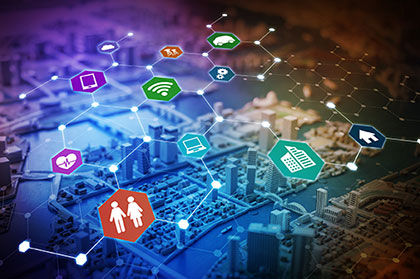March 20, 2019
 Reliable and robust civic infrastructure is important to the health and function of a city. Along with what we usually think of when we refer to public services and infrastructure, from services such as emergency responders, public schools, and health department, to structures such as roads and bridges; cities are now including factors that make a city “smart”. Connected, smart cities can improve the quality of life for its citizens in a number of ways, including environmental, financial, and social aspects. But what does being a smart city mean and why are cities making this one of their priorities?
Reliable and robust civic infrastructure is important to the health and function of a city. Along with what we usually think of when we refer to public services and infrastructure, from services such as emergency responders, public schools, and health department, to structures such as roads and bridges; cities are now including factors that make a city “smart”. Connected, smart cities can improve the quality of life for its citizens in a number of ways, including environmental, financial, and social aspects. But what does being a smart city mean and why are cities making this one of their priorities?
What is a Smart City?
A smart city is one that uses electronic and digital technologies and infrastructure to gather information to manage assets and resources more effectively and efficiently. Examples of ways to achieve this include investing in a municipal network of optical fibre and technologies such as 5G, free Wi-Fi routed via street lighting, and data collection sensors.
Cities can also work with developers to include functional design standards in the requirements for non-residential and mixed-use development, as well as encouraging commercially available 5G. These provide vital broadband infrastructure for a host of new smart city technologies and strategies that can be deployed.
By connecting the city, a municipality can use the data to better the lives of citizens, as well as enhance communication between citizens and the government. Data collected can be used to improve a variety of things from power management, to reducing pollution, increasing public safety, or offering improved services to residents.
Smart Cities for Environmental Improvements
To improve the environment, networks of connected devices and sensors can monitor environmental characteristics such as air quality, electricity use, water main leakage detection, and waste tracking. With the help of these sensors, smart applications and data analysis capabilities, cities can identify problems early on before they become a problem. Another example is the use of traffic light coordination systems to help keep traffic moving, reducing emissions – or saving energy by turning street lights off when the street is not busy. Similarly, smart LED street lights (which last longer and require less energy to operate) can be dimmed or brightened depending on their location and the time of day, leading to even less energy use – and municipal cost savings!
Smart Cities as Time and Money Saver
Speaking of cost savings, the smart city can use digital technologies to improve the efficiency of city services by eliminating redundancies, finding ways to save money and streamlining workers’ responsibilities. A smart city can better manage services and variable infrastructure based on input of data. By make adjustments a city can best use those resources or improve safety. For example, connected emergency response services can reach emergencies more quickly, saving lives.
To help residents, cities can gather data for all transit options, including: the best place to board the bus or closest train, what stop to get off, and even which door to exit from the subway. Cities can integrate transportation data, offering the public information on a variety of different transportation options, including public transit and bike and car shares.
Public Access to City Information
One big way a smart city is beneficial to citizens, businesses, and others is by easy access to city information. For example, having a public-facing website with real time permit, inspection and complaint data can help residents and business alike. Another is to have a dashboard of municipal performance metrics that residents can access.
Cities can also offer digital systems that reach and engage the public. Apps for services, like 311, can push out information via smart phones such as amber and emergency alerts and other civic messages that engage the public.
By investing resources and brainpower into building robust data infrastructure, the smart city can initiate change that benefits its residents, attracts business and improves the environment. Norwalk, as part of its ten year citywide plan, envisions some of the smart city initiatives above. To read more about Norwalk’s plans for City Systems, read chapter 4, starting on page 168 of the plan.




